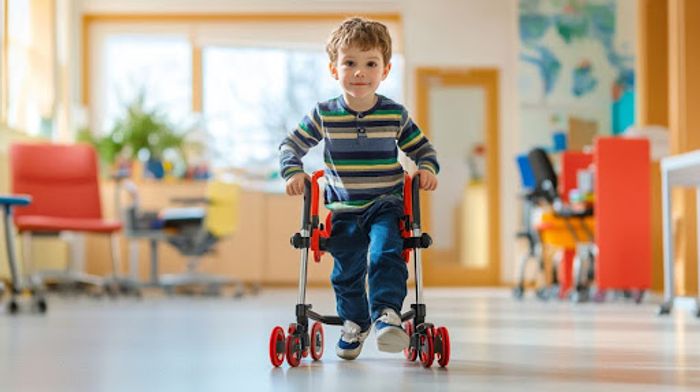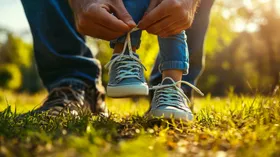Cerebral Palsy and Toe Walking: Understanding the Connection
A deeper look at how toe walking can affect mobility, balance, and overall quality of life for children with cerebral palsy.
Published January 9, 2025.

Navigating the world can present unique challenges for kids with cerebral palsy. One of these is toe walking, in which they consistently walk on the balls of their feet instead of using their heels. This can significantly impact a child's mobility, independence, and even emotional well-being.
Understanding the complexities of toe walking is key. With the right guidance and support, children with CP can explore unique movement patterns and achieve their full potential.
» Support your child's foot health with shoes designed for toe walking
Understanding Cerebral Palsy
Cerebral palsy (CP) is a neurological condition affecting movement and posture. [1] It is caused by neurological damage or developmental abnormalities early in life. While the initial neurological impact doesn't worsen over time, the symptoms a child experiences may change as they grow and develop.
CP primarily impacts muscle tone, posture, and mobility, leading to various movement patterns and challenges. Depending on which areas of the brain are affected, it can manifest as
- Ataxia—affecting balance and coordination
- Spasticity—causing muscle stiffness
- Dyskinesia—resulting in uncontrolled movements
» Is toe walking a sign of ADHD? Find out here
Symptoms of Cerebral Palsy
Children with cerebral palsy often show several characteristic signs that help in diagnosis. [2] Here are the key indicators that healthcare providers look for when assessing a child:
- Delayed Motor Milestones: Due to underlying muscle weakness and coordination challenges, children may take longer than typical to achieve developmental stages such as rolling over, sitting independently, crawling, or taking their first steps.
- Abnormal Muscle Tone: Presents as either increased muscle stiffness (hypertonia) or decreased muscle tone (hypotonia), significantly impacting movement and posture.
- Persistent Primitive Reflexes: Natural reflexes that typically disappear in early development remain active and interfere with voluntary movements.
- Asymmetrical Movements: This is particularly common in children with hemiplegia, where one side of the body is more affected.
- Associated Conditions: Cognitive challenges or seizures may accompany the physical symptoms in some children.
» Here's what to consider when buying shoes for your child with CP
The Link Between CP and Toe Walking
Toe walking manifests uniquely in cerebral palsy. It presents distinct characteristics that differentiate it from idiopathic toe walking or toe walking associated with other conditions. [6]
Here are the key features:
- Muscle spasticity creates significant tightness in the calf muscles and shortens the Achilles tendons, forcing the foot into a pointed position and making heel contact difficult during walking.
- Children with CP typically develop a rigid, scissored gait pattern where their legs may cross over each other during walking, accompanied by bent knees and tight thigh muscles.
- Balance becomes compromised as the altered gait pattern shifts the child's centre of gravity, making it harder to maintain stability during movement.
- Chronic toe walking can lead to progressive joint problems, including contractures and deformities that create additional mobility challenges over time.
» Learn more about the causes of idiopathic toe walking
Toe Walking in Different Types of CP
The presentation of toe walking varies across different types of cerebral palsy. For example:
- Spastic CP: Most prevalent, especially in diplegia. Increased calf muscle tone forces the foot into plantarflexion, hindering heel strike. [3]
- Athetoid CP: Toe walking can be inconsistent due to fluctuating muscle tone and involuntary movements, impacting balance and gait. [4]
- Ataxic CP: This type may exhibit toe walking as a balance compensation, though it's less common than other CP types. [5]
» Read our parents' guide to helping your little one to walk
Treatment Approaches for Toe Walking
Healthcare providers typically start with conservative, non-invasive treatments before considering more invasive options.
Physical Therapy
Through specialised gait training programs, PT forms the treatment foundation. Targeted exercises are used to stretch tight calf muscles, strengthen opposing muscle groups, and improve overall balance and coordination. [7]
Therapists use neuromuscular re-education techniques and task-specific training to enhance functional walking patterns.
» Explore these exercises to correct toe walking
Orthotic Devices and Bracing
These assistive devices, particularly ankle-foot orthoses (AFOs), provide essential support to maintain proper foot alignment and prevent the progression of toe walking by controlling unwanted plantarflexion of the foot. Dynamic AFOs offer controlled movement while maintaining stability.
» Try these effective strategies for stopping toe walking
Specialised Footwear
Shoes designed specifically for children with CP offer additional support through flexible soles, adjustable straps, and firm heel counters that help promote proper foot placement during walking. These shoes often include extra cushioning to reduce pressure on the forefoot.
Botulinum Toxin Injections
When conservative treatments don't provide enough improvement, botulinum toxin injections may be prescribed. These are often combined with physical therapy and bracing, offering temporary relief from spasticity and improving the effectiveness of other treatments.
» See what shoes podiatrists approve for kids
Surgery
Surgical options may be necessary in severe cases of toe walking in kids with CP. These can include tendon lengthening procedures to address shortened Achilles tendons and improve ankle flexibility.
Selective Dorsal Rhizotomy (SDR) may be considered in cases of significant spasticity. This surgical procedure involves modifying specific nerve roots in the spinal cord to reduce muscle stiffness and improve movement.
» Check out our guide for finding shoes for kids with sensory issues
When Toe Walking Becomes Difficult to Treat
It's important to recognise that toe walking may become more challenging to treat in some cases. This is typically in situations where:
- Long-standing spasticity has led to irreversible structural changes in muscles and joints.
- Treatment was delayed, or diagnosis occurred at a later age.
- Significant neurological involvement affects multiple aspects of motor control.
- Coexisting conditions complicate treatment approaches.
» Invest in supportive footwear to address your child's development
Preventing Complications
Early intervention is crucial when toe walking is identified. This proactive approach helps prevent complications and maximises treatment success. Consistent monitoring and treatment can help avoid:
- Chronic Pain: Toe walking places excessive stress on the feet, ankles, and legs, potentially leading to reduced mobility and decreased participation in physical activities.
- Joint Deformities: If toe walking continues without proper intervention, joint deformities may develop over time. These could potentially affect the ankles, knees, and hips and require more intensive treatment in the future.
- Injury: The unstable nature of toe walking increases the risk of falling, which can impact a child's confidence and willingness to explore their environment independently.
» Encourage their adventures with the best walking shoes for kids
Supporting Your Child's Journey
The journey of managing toe walking in children with CP isn't just about achieving perfect steps but embracing progress in all its forms. Through comprehensive care, innovative therapies, and unwavering support, children with CP can develop their potential for mobility and independence.
Even for kids who may never achieve traditional heel-toe walking, specialised footwear can provide comfort and stability. From adaptive shoes with extra ankle support to customised orthotic-friendly designs, modern footwear solutions help every child participate fully in life's adventures.
» Explore orthopaedic kids shoes designed to address toe walking
Disclaimer: First Walkers' information is intended for educational and informational purposes related to toddler footwear and feet. We encourage you to consider individual circumstances and consult qualified orthopaedists about specific conditions.
References
[1] https://pmc.ncbi.nlm.nih.gov/articles/PMC7082248/
[4] https://onlinelibrary.wiley.com/doi/abs/10.1111/j.1469-8749.1993.tb11568.x
[5] https://www.neurology.org/doi/abs/10.1212/cpj.0000000000000713
[6] https://www.google.com/url?q=https://journals.lww.com/pedpt/abstract/2020/01000/differentiating_between_idiopathic_toe_walking_and.2.aspx&sa=D&source=docs&ust=1736477715266405&usg=AOvVaw3EIWFZPSK7NStoDSXxivEY [7] https://www.nejm.org/doi/abs/10.1056/NEJM198803313181302





